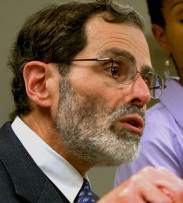 | THE STATISTICS ‘It’s definitely a very important observation that we need to track,’ said Dr. Alfred DeMaria of the state health department. |
By Stephen Smith
Globe Staff / August 18, 2009
– +
Since its arrival in Boston in late April, swine flu has proved to be a particular source of misery to the city’s African-American and Hispanic residents, causing hospitalizations at far higher levels than other groups, disease trackers report.
More than 3 of every 4 Bostonians who have spent time in the hospital because of the viral ailment are black or Hispanic, a finding that may reflect broader social ills, the top official at the Boston Public Health Commission said.
The same crowding in dense urban neighborhoods that fuels the spread of other germs may be spurring the transmission of swine flu, known scientifically as H1N1, disease specialists said. And the chronic conditions that are more prevalent in predominantly African-American and Hispanic neighborhoods - diabetes, for example - may make residents of those swaths of Boston especially vulnerable to the complications of flu.
“It’s disheartening to see these patterns on our first pass at collecting data around H1N1,’’ said Barbara Ferrer, executive director of the Boston health agency. “I thought people were getting sick everywhere at the same level, but it wasn’t true. Some of our neighborhoods were much more impacted by this.’’
They are neighborhoods such as Dorchester, East Boston, and Roxbury. And, as a result, health authorities are vowing to be especially assiduous in reaching out to those areas as the city embarks on a campaign to prepare for the potential double whammy of seasonal influenza and swine flu this fall.
Another part of that effort will focus on city workers: Yesterday, Mayor Thomas M. Menino pledged that all city employees can take two hours of paid time to get flu shots. And, at a City Hall press conference, the mayor said he intended to ask private employers to do the same.
While swine flu cases in recent weeks appear to have declined sharply, there was a potent reminder yesterday that the virus is still circulating and that it remains dangerous.
State health authorities reported that a 26-year-old with no history of chronic health problems had died of the viral ailment, the 11th Massachusetts resident to succumb to the disease. The victim, whose identity was not disclosed because of patient confidentiality laws, lived in Dukes County, which is principally Martha’s Vineyard.
Swine flu has mainly been a disease of the young, and it has struck most ferociously among adults and children with chronic health problems such as asthma, heart disease, and diabetes, as well as those with impaired immune systems.
The new report about swine flu’s variable racial and ethnic impact opens yet another window into a novel virus that has killed at least 447 across the country. But disease specialists cautioned that the preliminary data from Boston provide clues but no definitive answer.
“It’s definitely a very important observation that we need to track,’’ said Dr. Alfred DeMaria, top disease tracker at the state Department of Public Health. “But we don’t want to overinterpret it until we have more and better information.’’

Researchers at the US Centers for Disease Control and Prevention are examining the issue from the national perspective, and their report on the subject is undergoing internal review before being released, an agency spokesman said yesterday.
The Boston disease specialists found that of the 71 city residents hospitalized with swine flu, 49 percent were African-American, and 28 percent were Hispanic. In both cases, the hospitalization rates were double each group’s overall presence in Boston’s population.
Similarly, the two groups accounted for a disproportionately large share of the 477 laboratory confirmed cases of swine flu in the city.
Dr. Anita Barry, the top disease investigator at the city health agency, speculated that the composition of the city’s schools may provide a partial explanation.
“We know that school-aged children were primarily affected by H1N1, and in the Boston public school system, there is a majority of minority students,’’ Barry said.
The city investigators said the higher rates may also be a legacy of poverty and the demands of low-wage work. Parents in such jobs, Barry said, find themselves unable to stay home to care for ailing children because a day away from work means a day without pay. As a result, ill children are sometimes sent to school.
To see the potential consequences of crowding, disease investigators said, look to East Boston, a destination for migrants from South America and a densely packed neighborhood. There, the number of flu cases among 5- to 17-year-olds was significantly higher than the city average.
“If you look at the transmission of influenza, primarily by respiratory droplets,’’ Barry said, “people who live in more crowded conditions would be more likely to spread infection.’’
Menino is convening a meeting Friday of health professionals, educators, and business leaders to plot strategies to stop the spread.
Already, clinics such as the Codman Square Health Center are making plans to provide vaccination against both the seasonal flu and the swine strain. State health authorities are projecting that as many as 9 million flu vaccinations will be given statewide this fall.
“People are scared, and people are already asking if the flu vaccine is ready yet,’’ said Jan Smith, director of clinical services at the Codman Square center. “Anyone who walks through our door can get a flu vaccine, once it’s available, whenever they walk through the door. They won’t be told to come back.’’
No comments:
Post a Comment